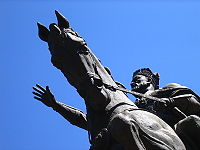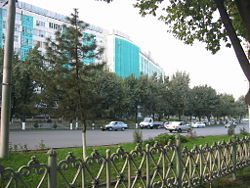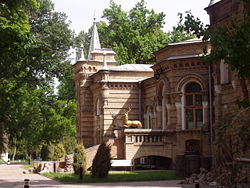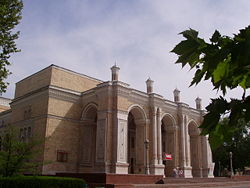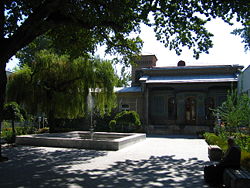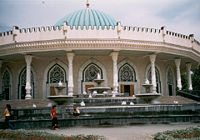Tashkent
2008/9 Schools Wikipedia Selection. Related subjects: Geography of Asia
| Tashkent Uzbek: Toshkent, Тошкент Russian: Ташкент |
|
| Location in Uzbekistan | |
| Coordinates: | |
|---|---|
| Country | |
| Province | Tashkent Province |
| Settled | 5th to 3rd centuries BC |
| Population (2006) | |
| - Total | 1,967,879 (inofficially - 3 mln) |
| Time zone | ( UTC+5) |
| Website: http://www.tashvil.gov.uz/ | |
Tashkent ( Uzbek: Toshkent, Тошкент; Russian: Ташкент, Turkish: Taşkent) is the capital of Uzbekistan and also of the Tashkent Province. The officially registered population of the city in 2006 was 2.1 million. According to unofficial data, the population is more than 3 million.
In medieval times the town and the province were known as "Chach". Later, the town came to be known as Chachkand/Chashkand, meaning "Chach City." (Tash in Turkic language means stone. Kand, qand, kent, kad, kath, kud--all meaning a city, are derived from the Sogdian, kanda, meaning a town or a city. They are found in city names like Samarkand, Yarkand, Penjikent etc.).
After the 16th century, the name was steadily changed slightly from Chachkand/Chashkand to Tashkand, which, as "stone city", was more meaningful to the new inhabitants than the old name. The modern spelling of Tashkent reflects Russian orthography.
Geography
Tashkent is located in a well watered plain to the west of the last Altai mountains on the road between Shymkent and Samarkand. Tashkent sits at the confluence of the Chirchik river and several of its tributaries and is built on deep alluvial deposits (up to 15 metres). It is a lively tectonic area suffering large numbers of tremors and some earthquakes. One earthquake in 1966 measured 7.5 on the Richter scale. The local time in Tashkent is UTC/GMT +5 hours.
History
Tashkent started as an oasis on the Chirchik River, near the foothills of the Golestan Mountains. In ancient times, this area contained Beitian, probably the summer "capital" of the Kangju confederacy.
The principality of Chach, whose main town had a square citadel built around the 5th to 3rd centuries BC, some 8 kilometers (5 mi) south of the Syr Darya River. By the 7th century AD, Chach had over 30 towns and a network of over 50 canals, forming a trade centre between the Sogdians and Turkic nomads. The region came under the sway of Islam in the early parts of the 8th century.
Hsien-tsang ( Xuanzang) mentioned the name of the city as Zhe-shi. The Chinese chronicles Sujshu, Bejshu and Tanshu mention a possession called Shi or Zheshi with a capital with the same name since the V c. AD [Bichurin, 1950. v. II].
Under the Samanid dynasty, the city came to be known as Binkath. However, the Arabs retained the old name of Chach for the surrounding region, pronouncing it al-Shash instead. The modern Turkic name of Tashkent (City of Stone) comes from Kara-Khanid rule in the 10th century.
The city was destroyed by Genghis Khan in 1219, although the great conqueror had found that the Khorezmshah had already sacked the city in 1214. Under the Timurids and subsequent Shaybanid dynasties the city revived, despite occasional attacks by the Uzbeks, Kazakhs, Persians, Mongols, Oirats and Kalmyks.
In 1809, Tashkent was annexed to the Khanate of Kokand. At the time, Tashkent had a population of around 100,000 and was considered the richest city in Central Asia. It prospered greatly through trade to Russia, but chafed under Kokand’s high taxes. The Tashkent clergy also favored the clergy of Bukhara over that of Kokand. However, before the Emir of Bukhara could capitalize on this discontent, the Russian army arrived.
In May 1865, General Mikhail Grigorevich Chernyayev (Cherniaev), acting against the direct orders of the tsar, and outnumbered at least 15-1 staged a daring night attack against a city with a wall 25 kilometers (16 mi) long with 11 gates and 30,000 defenders. While a small contingent staged a diversionary attack, the main force penetrated the walls, led by a Russian Orthodox priest armed only with a crucifix. Although defense was stiff, the Russians captured the city after two days of heavy fighting and the loss of only 25 dead as opposed to several thousand of the defenders (including Alimqul, the ruler of the Kokand Khanate). Chernyayev, dubbed the "Lion of Tashkent" by city elders, staged a "hearts-and-minds" campaign to win the population over. He abolished taxes for a year, rode unarmed through the streets and bazaars meeting common people, and appointed himself "Military Governor of Tashkent", recommending to Tsar Alexander II that the city be made an independent khanate under Russian protection.
The Tsar liberally rewarded Chernyayev and his men with medals and bonuses, but regarded the impulsive general as a "loose cannon", and soon replaced him with General Konstantin Petrovich Von Kaufman. Far from granting Tashkent its independence, Tashkent became the capital of the new territory of Russian Turkistan, with Kaufman as first Governor-General. A cantonment and Russian settlement were built across the Ankhor Canal from the old city, and Russian settlers and merchants poured in. Tashkent was a centre of espionage in the Great Game rivalry between Russia and the United Kingdom over Central Asia. The Trans-Caspian Railway arrived in 1889, and the railway workers who built it settled in Tashkent as well, bringing with them the seeds of Bolshevik Revolution.
20th century
With the fall of the Russian Empire, a provisional government attempted to maintain control in Tashkent. It was quickly overthrown and local Muslim opposition crushed. In April 1918, Tashkent became the capital of the Turkestan Autonomous Soviet Socialist Republic ( Turkestan ASSR). The new regime was threatened by White forces, basmachi, revolts from within, and purges ordered from Moscow. Tashkent fell within the borders of the Uzbek SSR, and became the capital of the Uzbek SSR in 1930, displacing Samarkand.
The city began to industrialize in the 1920s and 1930s, but industry increased tremendously during World War II, with the relocation of factories from western Russia to preserve the Soviet industrial capacity from the invading Nazis. The Russian population increased dramatically as well, with evacuees from the war zones increasing the population to well over a million. (The Russian community would eventually comprise nearly half of the total residents of Tashkent.)
On April 26 1966, Tashkent was destroyed by a huge earthquake (7.5 on the Richter scale) and over 300,000 were left homeless.
At the time of the collapse of the Soviet Union in 1991, Tashkent was the fourth largest city in the country and a centre of learning in the science and engineering fields.
Tashkent was a very Soviet city, with few reminders of its position on the Silk Road or its 2000+ years of history. At the moment, it is the most cosmopolitan city in Uzbekistan, with large ethnic Russian minority. The city is noted for its tree lined streets, numerous fountains, and pleasant parks. As capital of the nation, it has also been the target of several terrorist attacks since Uzbekistan gained independence, which the government has attributed to Islamic fundamentalists.
Since 1991, the city has changed economically, culturally, and architecturally. The largest statue ever erected for Lenin was replaced with a globe, complete with a geographic map of Uzbekistan over it. Buildings from the Soviet era have been replaced with new, modern buildings. One example is the "Downtown Tashkent" region, which includes the 22-storey NBU Bank building, an Intercontinental Hotel, International Business Centre, and the Plaza Building.
In 2007, Tashkent was named the cultural capital of the Islamic world as the city is home to numerous historic mosques and religious establishments.
Sights
Due to the destruction of most of the ancient city during 1917 revolution and, later, to the 1966 earthquake, little remains of Tashkent's traditional architectural heritage. Tashkent is, however, rich in museums and Soviet-era monuments.
- Kukeldash Madrassa
Dating back to the reign of Abdullah Khan (1557-1598) it is currently being restored by the provincial Religious Board of Mawarannahr Moslems. There is talk of making it into a museum, but it is currently being used as a mosque.
- Chorsu Bazaar
Near the Kukeldash Madrassa, this huge open air bazaar is the centre of the old town of Tashkent. Everything imaginable is for sale.
- Telyashayakh Mosque (Khast Imam Mosque)
Contains the Uthman Qur'an, considered to be the oldest extant Qur'an in the world. Dating from 655 and stained with the blood of murdered caliph Uthman, it was brought by Timur to Samarkand, seized by the Russians as a war trophy and taken to Saint Petersburg. It was returned to Uzbekistan in 1989.
- Yunus Khan Mausoleum
A group of three 15th century mausoleums, restored in the 19th century. The biggest is the grave of Yunus Khan, grandfather of Mughal Empire founder Babur.
- Palace of Prince Romanov
During the 19th century Grand Duke Nikolai Konstantinovich (1850-1918), a first cousin of Alexander III of Russia was banished to Tashkent for some shady deals involving the Russian Crown Jewels. His palace still survives in the centre of the city. Once a museum, it has been appropriated by the Ministry of Foreign Affairs.
- Alisher Navoi Opera and Ballet Theatre
Built by the same architect who designed Lenin's Tomb in Moscow, Aleksey Shchusev, and built with Japanese prisoner of war labor in World War II, this theatre hosts Russian ballet and opera.
- Fine Arts Museum of Uzbekistan
Contains a major collection of art from the pre-Russian period, including Sogdian murals, Buddhist statues and Zoroastrian art, along with a more modern collection of 19th and 20th century applied art, such as suzani embroidered hangings. Of more interest is the large collection of paintings "borrowed" from the Hermitage by Grand Duke Romanov to decorate his palace in exile in Tashkent, and never returned. Behind the museum is a small park, containing the neglected graves of the Bolsheviks who died in the Russian Revolution of 1917 and to Ossipov's treachery in 1919, along with first Uzbekistani President Yuldush Akhunbabayev.
- Museum of Applied Arts
Housed in a traditional house originally commissioned for a wealthy tsarist diplomat, the house itself is the main attraction, rather than its collection of 19th and 20th century applied arts.
- History Museum
Tashkent's largest museum, housed in the ex-Lenin Museum.
- Amir Timur Museum
An impressive building with brilliant blue dome and ornate interior (see photo to the right). Inside, the exhibits of Timur and of President Islom Karimov vie for the visitor's attention. The gardens outside contain a statue of Timur on horseback, surrounded by some of the nicest gardens and fountains in the city.
- Navoi Literary Museum
A commemoration of Uzbekistan's adopted literary hero, Alisher Navoi, with replica manuscripts, Persian calligraphy and 15th century miniature paintings.
City built environment
- The only metro system in Central Asia. ( Astana's and Almaty's only being in their construction stages.)
- Tashkent Airport is the largest in the country, connecting the town to Asia, Europe and the American continents.
- The largest city square (Independence Square) in the former Soviet Union, which once held the tallest statue of Lenin (30 meters tall) in the Soviet Union. Lenin was replaced in 1992 by a globe showing a map of Uzbekistan.
- Government, trade union and private medical and dental facilities.
- Offices of several American and European consulting firms like Ernst & Young Ltd, Deloitte & Touche, PricewaterhouseCoopers and Gravamen Fidelis and Fides LLP
Education
- Several universities and institutions of higher learning:
- Tashkent State Technical University
- International Business School 'Kelajak Ilmi'
- Tashkent University of Information Technologies
- Westminster International University in Tashkent
- National University of Uzbekistan
- University of World Economy and Diplomacy
- Tashkent State Economic University
- Tashkent State Institute of Law
- Tashkent Institute of Finance
- State University of Foreign Languages
- Conservatory of Music
- Tashkent State Medicine Academy
- Institute of Oriental Studies.
Public Transportation
- Buses
- Light rail trains/Street cars
- Metro system
- Trolley buses
Sister Cities
Sport
Famous cyclist Djamolidine Abdoujaparov and footballer Vassilis Hatzipanagis were born in the city. Tennis player Denis Istomin was born and lives in the city.

